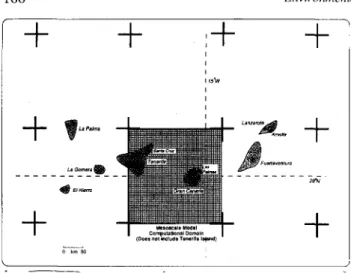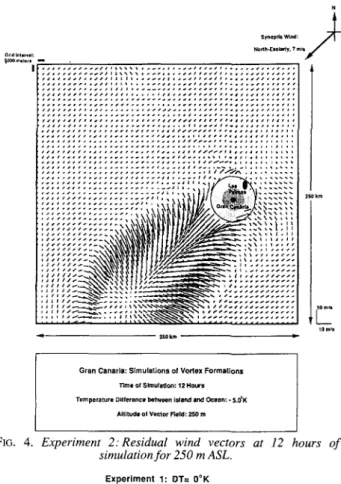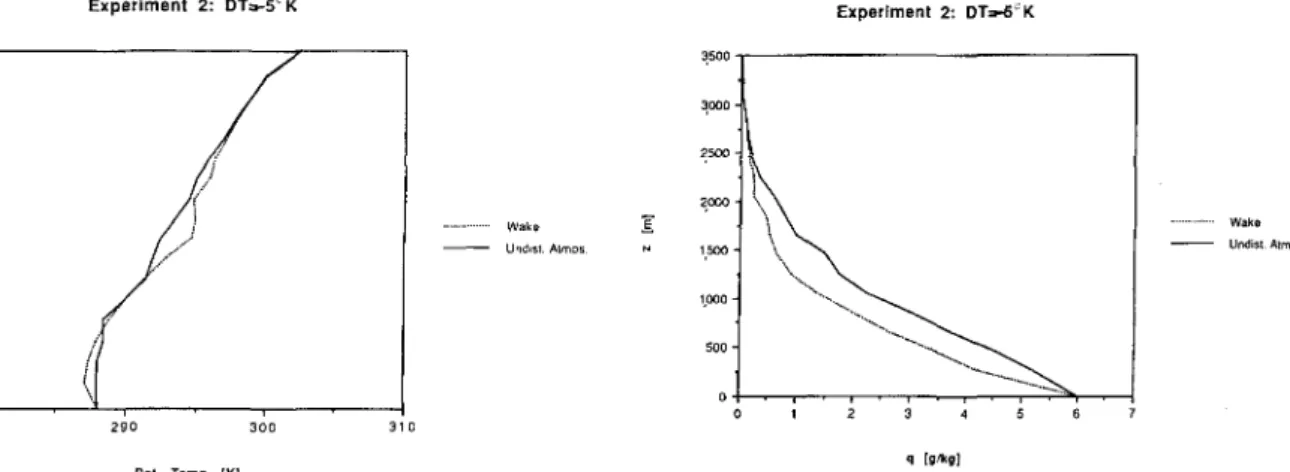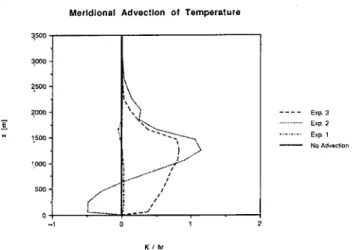SHORT COMUNICATIONS & REPORTS
An Example of Climate-relevant Processes Unresolved
by Present-day General Circulation Models
INTRODUCTIONGlobal-change issues are attracting increasing atten-tion by the media and the general public, so that in many countries climate research has become a theme of high priority. The possibilities and consequences of accelerated atmospheric warming in the decades to come are indeed a daunting challenge for both scientists and policymakers. One of the few tools available to the climate research community which have a measure of predictive capability are the so-called General Circulation Climate Models, or GCMs. These highly complex numerical simulation models attempt to reproduce as many as possible of the elements of the atmosphere, hydrosphere, cryosphere, geosphere, and living matter, in order to take into account the complex interactions which occur between these different components of the climate system. Scenarios and sensitivity tests are then possible under different hypo-theses of increased 'greenhouse' gas concentrations resulting from human activity. While many GCM simu-lations of future climate trends were undertaken in the 'eighties, their alarming predictions for the 21st century were highlighted by the publication of the Intergovern-mental Panel on Climate Change (IPCC) Report (Hough-ton et al., 1990)* in preparation for the Second World Climate Conference which took place in Geneva in October and November 1990.
The predictions of GCMs are open to controversy because many of the important feedback mechanisms between the atmosphere and other elements of the climate system are poorly, if at all, taken into account; in particular, coupling of the oceans to the atmosphere, and the interactions between clouds and radiation, are still incompletely understood. Spatial and temporal resolution is also a major drawback of climate models which of necessity even on the largest supercomputers, are not in a position to simulate small- and regional-scale processes. Consequently, GCMs have problems of reproducing details of exisiting patterns of climate, as was pointed out by Dickenson (1989), so that the validity of simulations of future climate trends is far from certain. For the same reasons, it is probable that many climatically-relevant processes taking place on a subgrid-scale are totally ignored by the GCM, as has been emphasized by several Authors, such as Pielke (1988, 1990). Certain processes occurring in the atmospheric boundary-layer (ABL) may have a definite influence on climatic tendencies, despite the fact that equilibrium times in the ABL may be one or more orders of magnitude smaller than for other climate subsystems (Saltzmann, 1983; Henderson-Sellers & McGuffie, 1987). Indeed, this is a further problem inherent in GCMs which attempt to couple systems of vastly different time-scales.
Subgrid-scale contributions to climate can be inves-tigated either through observations or through numerical experimentation with finer-scale models, such as mesoscale (regional-scale) atmospheric models. Infor-mation from a mesoscale study, either experimental or
* See also the paper by the Chairman of IPPC, Professor Bert Bolin, published on pp. 297-303 of our latest Winter issue (Vol. 18, No 4) and entitled 'Man-induced Global Change of Climate: the IPCC Findings and Continuing Uncertainty Regarding Preventive Action.' — Ed.
mathematical, can shed light on the importance of a particular process and eventually help in improving the parameterization of that process or set of processes in a larger-scale model.
As an example of what may be a mesoscale mechanism of climatic relevance, simulations have been undertaken of dynamic and thermal processes in the lee of an island. The present study is based on the Canary Islands, which lie around 28° latitude in the North Atlantic, some 200 km off the nearest part of the coast of West Africa. These islands are under the predominant influence of the Trade-winds, which for most of the year blow from the north-east, bringing unperturbed air masses to the islands. In order to avoid the complexity of dynamic wake-interactions between islands, a single island (Gran Canaria) was chosen in this study to characterize and emphasize the mechanisms which will be reported in this paper.
The mesoscale model used in this study covers a domain of 250 x 250 km, which would represent a single-grid area in a high-resolution GCM; in this model domain, Gran Canaria island represents less than 5% of the total surface-area, and would therefore be completely missed out by the grid of a GCM. What we shall attempt to show in this paper is that the dynamic and thermodynamic perturbations induced by the presence of a single island can be far from insignificant.
NUMERICAL EXPERIMENTS AND MODEL RESULTS The numerical model used in this study is the hydrostatic DREAMS model (Differential-equation RE-gional Atmospheric Modelling System) which is, in fact, an updated version of the MESOCONV model used in a number of investigations of regional-scale boundary-layer processes. These include studies of cellular cloud convection over an oceanic surface (Beniston, 1984, 1985), cloud-radiation interactions (Beniston & Schmetz, 1985), and air quality in complex terrain (for example, Beniston, 1987; Beniston et al., 1990). Numerous inter-comparisons with reality, as reported in those and other publications, have established the model's capability of simulating physical atmospheric processes on a regional scale. The updated model is essentially a streamlined, vectorized version which runs on the CRAY-2 super-computer at the Swiss Federal Institute of Technology in Lausanne. A horizontal model domain of 250 km was used, with a 5 km grid interval. In the vertical, 20 vertical levels have a spacing ranging from 50 m close to the surface, to 250 m at higher levels.
For the purpose of this study, only the Gran Canaria island was taken into account, to investigate the perturb-ation of a single island on the atmospheric flow. Fig. 1 illustrates the geographical area of the Canaries and the model extent used in this particular numerical experi-ment; Grand Canaria island is located off-centre in the domain in order to be able to follow the development of the wake and vortices in the lee of the island over a longer time-period. The island is located away from the lateral boundaries in order to avoid problems of wave inter-ference between the edges of the model and the island. The bold crosses indicate what would be the typical mesh-size of a 'high-resolution' GCM.
•• 1 »••' ffli La Palma 0 km 50 a a B M H B f l i: : :" -: :-: jr.!-— is'w Ij. :. ::: .-: ::. :. TTraHRs^nUI Ll:!;:l!::l!il!;:l;[;l..;j'..: .1 .':• " ':" l
• +
21TN +FIG. 1. The Canary Islands and the mesoscale model domain used in
this study.
The synoptic flow is initialized at 7 m/s from the NE, and computations are undertaken for 12 hours of model time, during which period the wake in the first 150 km of the lee is well developed and in a relatively steady state. The ocean surface is kept at a constant 288°K; a neutral boundary-layer extends to 1,050 m above sea-level (Trade-wind inversion layer), followed by stable stratification through to the model's top. Specific humidity close to the surface is initially set at 6 g/kg, and the moisture profile decreases monotonically with height through to the model top where it reaches a low value of 0.1 g/kg.
Due to a lack of detailed climatology of the Canary Islands, it was not possible to undertake meaningful experi-ments with the mesoscale model which could be compared with reality. A number of hypothetical simulations have therefore been carried out to investigate how Gran Canaria may, in certain circumstances, perturb the Trade-wind flow. While the study may not have a statistical significance in the climatological sense, and does not pretend to reproduce the real climatology of the region, it will show that island-induced perturbations can be sufficiently important to warrant some form of representation as a subgrid-scale phenomenon within a GCM grid.
The mesoscale model simulations consider three pro-cesses acting simultaneously:
1) Adiabatic ascent and descent of air as the flow is forced over the mountainous island. In a non-neutral atmosphere, this will perturb the hydrostatic pressure field through vertical temperature redistribution. 2) Wake and vortex formation in the lee of the island. 3) Additional thermal perturbation to the system
result-ing from the temperature difference between the island and its oceanic environment. Indeed, three different experiments were undertaken with island/ocean temperature differences of 0°K, -5°K, and +5°K; these will be referred to as Experiments 1, 2, and 3, respectively. According to the sign of this temperature differential, the wake and vortex structure is seen to exhibit different behaviour. Furthermore, dynamic and thermodynamic transports in the lee of the island are affected by its thermal characteristics and not solely by the dynamic effect of the wake. Experiments 2 and 3 can be considered to represent extremes of nocturnal and diurnal island/ocean temperature differences, respectively; in an unperturbed synoptic flow, these temperature differences are probably one of the most
an additional feature of island-induced wakes.
Dynamic Fields
At six hours of simulation of Experiment 1, the pattern of residual wind at 250 m above sea-level (ASL) shows a double vortex formation on either side of a diagonal extending from Gran Canaria towards the SW (Fig. 2). The SE vortex is anticyclonic in nature, while the NW vortex is rotating in the opposite direction, i.e. in the cyclonic sense. The vortex pattern is not quite symme-trical on either side of the diagonal, due to the small contribution of the Coriolis acceleration. Island wake effects are observed in the form of strong residual flow directed towards the island. After 12 hours of simulation, the vortex system has moved towards the SW by about 90 km. The wake has extended towards the SW without any major broadening; its width remains close to that of the island's cross-section.
The nature of the perturbation induced by a 'cold
Gran Canaria: Simulations of Vortex Formations Time of Simulation: 6 Hours Temperature Difference between Island end Ocean: 0.0V
Altitude of Vector Field: 250 m
FIG. 2. Experiment 1: Residual wind vectors at 6 hours of simulation
for 250 m ASL.
island' is somewhat different from the other two experiments, in which a double vortex formation occurs at six hours of simulation. In the present case, a vigorous system can be observed at the SW end of the lee wake, in which air is expelled from a central core (Fig. 3). This phenomenon is dominant and overshadows the tendency to double vortex formation. The system seems to be very much analogous to a front, with a sharp discontinuity occurring between the perturbed and the unperturbed parts of the flow. The probable reason for this vigorous behaviour of the residual flow is that the cold-island generates a strong subsiding motion, comprising not only air flowing downslope in the lee of the island, but also sinking of air due to its cooling in contact with the island.
167
Synoptic Wind: Noi-lh-EMterly, T nvs
L
Gran C a n a d a : S i m u l a t i o n s of Vortex F o r m a t i o n s Time of simulation: 6 Hours Temperature Difference between Island and Ocean:-5.0'K
Altitude of Vector Reid: 250 m
FIG. 3. Experiment 2: Residual wind vectors at 6 hours of simulation
for250mASL.
This results in a cold cell (i.e. a region of higher pressure) from the surface to at least the inversion level, leading to the vigorous outpouring of air observed in the vicinity of the wake 'front'. After 12 hours of simulation (Fig. 4), the 'front' is moving out of the model domain, but activity along the wake is very much in evidence, with significant outflow of air at the lateral boundaries of the wake. Furthermore, the wake has fanned out with distance downwind, unlike the other two experiments where the wake cross-section remains approximately proportional to the island's diameter.
The 'warm island' case exhibits similar tendencies to Experiment 1, though with somewhat more intensity of the vortex features as a result of the thermal stimulation of the dynamics.
Thermodynamic Fields
Figs 5 and 6 illustrate the perturbations in heat and moisture across the wake simulated in Experiment 1, for an east-west cross-section 100 km south of the island at 12 hours of simulation for 250 m, 1,050 m, and 1,650 m ASL (within the ABL, at the Trades inversion, and in the stable layers above). At all levels, a characteristic signal is observed in which temperature rises in the wake region and humidity exhibits a corresponding decrease. The amplitude of the temperature fluctuation varies from less than 1°K at low levels to over 2°K at higher levels; closer examination shows that, at the edges of the wake, there is a decrease of temperature close to the lateral boundaries of the model. Moisture is seen to drop by about 50% between the wake edge and wake centre at the Trades inversion level (1,050 m ASL) in this experiment. The thermodynamic fluctuation across this wake allows the 3D flow pattern to be deduced: subsiding air occurs in the wake itself, due to descent after passing over the mountains, and further downstream as a result of
diver-G r a n C a n a r l a : S i m u l a t i o n s of Vortex F o r m a t i o n s Time of Simulation: 12 Hours Temperature Difference between Island and Ocean:. 5.0'K
Altitude of Vector Reid: 250 m
FIG. 4. Experiment 2: Residual wind vectors at 12 hours of
simulation for 250 m ASL.
Experiment 1: DT= 0°K
1,050 rr 1650 m
50 100 150 200 250
FIG. 5. Experiment 1: Horizontal potential temperature profile at
250 m, 1,050 m, and 1,650 m, ASL.
Experiment 1: DT= 0°K
1,650 m
100 150 200 250 Distance [km]
FIG. 6. Experiment 1: Horizontal specific humidity profile at 250 m,
the less perturbed atmosphere, it tends to rise at the wake boundaries, thereby leading to cooler boundary-layer air which is uplifted to higher levels; this rising air also picks up moisture from the surface and transfers it upwards.
The vertical profiles of potential temperature, 0, and specific humidity, q, for Experiment 2, are given in Figs 7 and 8, respectively. The profiles are taken at a point within the wake, 100 km south of the island and at the wake centre. They clearly underline the cooling influences of the island at low levels, the crossover to subsistence warming at about 1,600 m ASL and through to 2,500 m ASL, and the considerable drying at all levels to 2,500 m ASL and above. The drying is most important at the Trade inversion level, where a drop of over 50% is observed relative to the unperturbed flow (given by the solid lines).
Experiment 2: DTa-5'K
Wake Undist. Alrr
Pol. T.mp. [Kl
transports reach l°K/hr. In Experiment 3, subsidence warming associated with horizontal advection of air in contact with a 'warm' island, result clearly in a column of warm air advection directed southwards, averaging 0.5°K/hr from the surface to 2,000 m ASL.
The meridional transports of humidity illustrated in Fig. 10 all indicate the southward advection of dry air resulting from the loss of moisture within the wake. The experiments in which island surface temperature is identical to that of the ocean exhibit the least advection, while those in which the island is colder or warmer than the ocean show quasi-identical advection profiles. These reach a maximum of between 0.5 and 0.6 g/kg/hr at the summit of the Trades' inversion.
Experiment 2: DT=-6=
K
Wake
Undist, Ainu
FIG. 7. Experiment 2: Vertical potential temperature profile in the FIG. 8. Experiment 2: Vertical specific humidity profile in the wake.
wake.
Southward Transport of Climate Variables
The horizontally-averaged meridional advection of heat and moisture as air crosses the southern boundary of the model will be briefly analysed here. The profiles given in Figs 9 and 10 can be compared directly with a column of air in a GCM located in the same geographical position, but where the horizontal grid is incapable of resolving either the Canary Islands themselves or the atmospheric perturbations resulting from the islands' presence. The GCM would 'see' the area as one of large-scale homo-geneity in wind velocity, temperature, and moisture; in this case the advection terms would be nil, as no gradients in the dynamic and thermodynamic terms would be present. The objective here is therefore to determine the importance of these meridional transports in the case of the mesoscale simulations compared with the 'zero-advection' case of a GCM which does not resolve the island-induced phenomena.
In Fig. 9, advection profiles are given for potential temperature 0; positive values indicate warm-air transport southwards, while negative values relate to cooler trans-ports southwards. In the case of Experiment 1, the average advection is close to zero at all levels and indicates that advection profiles in the wake interior, wake boundary, and outside the wake, cancel out. For Experiment 2, the cold air advection at low levels is not surprising, as the 'cold' island processes were observed to dominate in the temperature signals. At heights above 500 m, however, the effects of
CONCLUDING REMARKS
A numerical study has been undertaken to simulate wake and vortex characteristics due to the presence of a single island (Gran Canaria), and to estimate whether such perturbations to the Trade-wind flows, unresolved by present-day General Circulation Models, could have cli-matic relevance. The study has shown that certain features of an island-induced wake, such as return flows within the lee of the island, vortex generation, and vortex shedding and displacement southwards, are adequately reproduced by the model when compared with theoretical consi-derations. For example, Chopra (1973) has established parameters for vortex shedding and displacements from satellite observations of the Canary Islands. True vortex shedding rates of one vortex each 6 hours are to be compared with model-computed rates of one vortex each 4 hours; vortex displacement velocities in the lee of the islands are observed to occur at 71 % of the Trade-wind flow velocity; the model results show displacement velocities at 65% of synoptic wind velocity.
An attempt has been made to quantify the dynamic and thermodynamic features of the lee wake, by analysing the vector fields and the heat and moisture profiles in hori-zontal and vertical cross-sections at different levels. It has been observed that major fluctuations in dynamics and thermodynamics occur in the wake region, and that these are enhanced by the surface temperature characteristics of the islands, i.e. thermal perturbations due to a 'warm' or a
169
Meridional Advection of Temperature Meridional Advection of Humidity
3ooo -2500 • 2000 1,500 1,000 500 0 -\ < / - " " i f Exp. 3 Exp. 2 Exp. 1 No Adveclio oauu " 3000 2500 - 2000,500 -(000 500 0
-¥ i
A ! i \ i N N ~ \ — i E • E xp.3 xp 2 xp. 1 NoAdveclioFIG. 9. Average potential temperature advection across the outflow
(southern) boundary of the model.
'cool' island modulate the lee dynamics. Whether this perturbation is significant in terms of climate is difficult to evaluate. On one hand, the meridional advection of momentum, heat, and moisture, is certainly important, especially when the island surface temperature is not in equilibrium with that of the ocean; warming can reach l°K/hr, and drying 0.5 g/kg/hr in the hypothetical examples given. On the other hand, in the absence of a detailed climatology of the Canary Islands, which would allow an estimation of the average duration of synoptic conditions and the diurnal temperature cycle on a yearly basis, it is not possible to provide an exact figure of the discrepancy between the resolved wake effects and an unperturbed atmosphere as 'seen' by a GCM in these latitudes. However, the magnitude of meridional drying and warming is such that the question of parameterization of these effects as a subgrid-scale process in a GCM needs to be seriously addressed.
SUMMARY
A numerical study has been undertaken with a meso-scale atmospheric model to investigate whether dynamic and thermodynamic perturbations induced by the presence of an island in a Trade-wind flow can be sufficiently important to warrant some form of repre-sentation as a subgrid-scale phenomenon in a General Circulation Climate Model.
The study has shown that the processes in the lee of the island — wake and vortices — have a definite influence on atmospheric processes downwind of the island com-pared with an unperturbed situation in which no island is present. A General Circulation Model would not 'see' a small island within its coarse grid, and as a result the island-induced perturbations would not be perceived by such a model. Attempts to quantify the transports of heat and moisture by the wake-and-vortex system indicate that they may be of climatic relevance if they act on sufficiently long time-scales.
REFERENCES
BENISTON, M. (1984). A numerical study of atmospheric cellular convection. Dyn. Atmos. Oceans, 8, pp. 223^12, illustr.
FIG. 10. Average specific humidity advection across the outflow
(southern) boundary of the model.
BENISTON, M. (1985). Organization of convection in response to initial and lower boundary conditions in a mesoscale numerical model. Contr. Atm. Phys., 58, pp. 31-52, illustr.
BENISTON, M. (1987). A numerical study of atmospheric pollution over complex terrain in Switzerland. Boundary Layer
Meteoro-logy, 41, pp. 75-96, illustr.
BENISTON, M. & SCHMETZ, J. (1985). A three-dimensional study of mesoscale model response to radiative forcing. Boundary Layer
Meteorol., 31, pp. 149-75, illustr.
BENISTON, M., WOLF, J. P., BENISTON-REBETEZ, M., KOLSCH, H. J., RAIROUX, P. & WOSTE, L. (1990). Use of Lidar measurements and numerical models in air pollution research. / . Geophys. Res., 95, D7, pp. 9879-94, illustr.
CHOPRA, K.P. (1973). Atmospheric wake and oceanic flow problems introduced by islands. Adv. Geophys., 16, pp. 297^-21, illustr. DICKENSON, R.E. (1989). Phil. Trans. Roy. Soc, Ser. B, pp. 423-31,
illustr.
HENDERSON-SELLERS, A. & MCGUFFIE, K. (1987). A Climate Modeling Primer. J. Wiley, Chichester, England, UK: 217 pp.,
illustr.
HOUGHTON, J.T., JENKINS, G.J. & EPHRAUMS, J.J. (1990). Climate Change: The IPCC Scientific Assessment. Cambridge
Univer-sity Press, Cambridge, England, UK: 365 pp., illustr.
PIELKE, R.A. (1988). Evaluation of climate change using numerical models. Pp. 61-72 in Monitoring Climate for the Effects of
Increasing Greenhouse Gas Concentrations (Eds R.A. PIELKE &
T. KITTEL). CIRA Publications, Fort Collins, Colorado, USA: [not available for checking].
PIELKE, R.A. (1990). Overlooked Scientific Issues in Assessing
Hypothesized Greenhouse Gas Warming. Electric Utility
Business Environment Conference and Exhibition, March 1990, Denver, Colorado. [Not available for checking.]
SALTZMANN, B. (Ed.) (1983). Theory of Climate (Advances in Geophysics, Vol. 25). Academic Press, New York, NY, USA: 505 pp., illustr.
MARTIN BENISTON, Programme Director
Swiss National Climate Programme (ProClim) Bdrenplatz 2
3001 Bern and Institute of Geography
Swiss Federal Institute of Technology Zurich, Switzerland,
&
J. PEREZ-SANCHEZ
ETS Ingenieros Industrials Universidad de Gran Canada Las Palmas, Spain.



